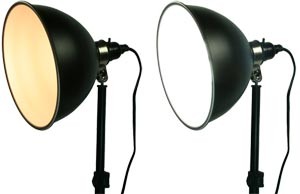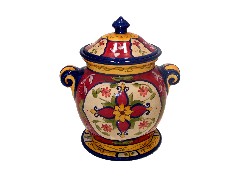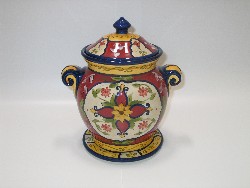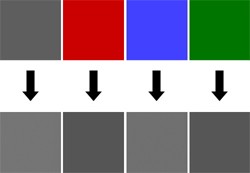Studio Lighting
Lighting is
just as important to creating great photos as a digital
camera. You can spend lots of money on a sophisticated
camera but if you don't have an adequate lighting setup,
it will show in your photos.
Studio lighting
can be broken down into two categories, continuous and
flash. Continuous lighting has many advantages when photographing
products.
-
It's relatively
inexpensive, and makes a good starting point for anyone
on a small budget.
-
You can see
what the light is doing and where the shadows and
highlights are. What you see is what you get.
-
Some continuous
light produce more heat than light, very uncomfortable!
Compact fluorescent bulb produce more light than heat.
They operate cool, energy efficient, long lasting,
and some are daylight balanced with good color rendering.
Compact Studio Lights
There are several
types of continuous lights that produce more heat than
light such as tungsten, incandescent, or flood lamps.
These bulbs have a color temperature (the color of the
light) around 2,700K-3,600K. To your eyes, the light
from a tungsten bulb looks white, but it isn't. Color
temperature is measured in degrees Kelvin, daylight is
around 5,000K-5,500K and a tungsten bulb is more like
2,800K and therefore records on daylight balanced film
as yellow.
The big issue
with tungsten is the filament in the bulb burns and leaves
a small residue on the inside of the glass bulb. This
means that the color of the light gradually becomes more
yellow as the bulb ages. Adjusting for tungsten color
balance can be corrected through your camera or with software
but can be complicated.
This brings
us to flash. Studio strobe lights are great for portrait
photography because they can produce a lot of light with
less heat ?more comfortable for a model. Studio
strobe lights could work fine with product photography
but requires more space and you donít see what you get.
With strobes, it may be difficult to get a long depth
of field shot a sharp photograph but its great for quick,
repetitious shots where depth-of-field is not critical
such as school photography or portraits for ID cards.
In retrospect,
we developed the D-Flector to provide the simplest way
to get a quick photo without the hassle. The D-Flectorís
unique reflective background can provide great product
shots without spending time setting up lighting, allocating
dedicated space, or intricate knowledge of photo software
tools to ready product images for marketing purposes.
Color Temperature
By convention, yellow-red colors
(like the flames of a fire) are considered warm, and blue-green
colors (like light from an overcast sky) are considered
cool. Color temperature is measured in Kelvin (K) temperature.
Cool light is preferred for visual tasks because it produces
higher contrast than warm light. Warm light is preferred
for living spaces because it is more flattering to skin
tones and clothing.


Household lights with a color
temperature of 2700?600 K (left) is generally used for
most indoor general and task lighting applications. Daylight
color temperature (right) lighting is preferred for product
photography and the film industry because it provides
the best contrast with primary colors.
| 1700 K |
Match flame
|
| 1850 K |
Candles |
| 2800 K |
Tungsten lamps |
| 3000 K |
Household light bulbs |
| 3400 K |
Studio lamps, photofloods,
etc... |
| 4100 K |
Clear flash bulbs |
| 5000 K |
Daylight |
| 5500 K |
The sun at noon |
| 6000 K |
Bright sunshine on clear
day |
| 6420 K |
Xenon arc lamp |
| 7000 K |
Slight overcast day |
| 11000 K |
Sunless blue skies |
Color Rendition
Color rendering is how colors
appear when illuminated by a light source and can be considered
as important to light quality as color temperature. Most
objects are not a single color, but a combination of many
colors. Light sources that are deficient in certain colors
may change the apparent color of an object. The Color
Rendition Index (CRI) is a 1?00 scale that measures a
light source's ability to render colors the same way sunlight
does. The top value of the CRI scale (100) is based on
illumination by a 100-watt incandescent light bulb. A
light source with a CRI of 80 or higher is considered
acceptable for most indoor residential applications.
Glare
The excessive brightness from
a direct light source that makes it difficult to see what
one wishes to see. A bright object in front of a dark
background usually will cause glare. Bright lights reflecting
off a television or computer screen or even a printed
page produces glare. Intense light sources—such as bright
incandescent lamps—are likely to produce more direct glare
than fluorescent lamps. However, glare is primarily the
result of relative placement of light sources and the
objects being viewed.
Basic Studio Setup
A typical studio for product
photography includes a background, lights, tripod and
other accessories. Most home business owners use
their garage or small office for their studio setup.
These studios can take up a lot of space especially with
a background hanging from the ceiling and light stands
carrying high-powered lamps by make-shift electrical wiring.
If not done correctly, it will show in the pictures.
Backgrounds
The ideal studio background
for selling items over the internet is a clean, non-distractive
background. The D-Flector
photo studio resembles a briefcase and unfolds
into a tabletop background stand. It contains a
reflective background that "illuminates" when photographed
with flash. The result is a pure white background
image with a floating-on-air effect used in catalogs,
publications, advertising materials and web sites.
It also includes a matte white background when soft lighting
is more desirable and a black background for adding contrast
to white of shiny items.
Using our Reflective Background
The D-Flector
contains a unique reflective background that illuminates
when photographed with flash or strobe lighting as the
main light source. The background of the photograph is
captured with a pure white background color. The object
appears to be floating-on-air. Using the reflective background
with an on-camera flash can be the easiest way to achieve
a pure white background! The D-Flector is very affordable,
easy to use and produces great results very quickly.
Other white
backdrop materials (like paper or muslin) can leave a
grayish background tone. The D-Flector contains
fine glass particles under the photographic surface that
redirects light back to the source to give you that even
white background. Because of this, the D-Flector
background appears grayish until flash/strobe is applied
and captured.
| 
|

|
| The D-Flector has a reflective
background material. When used with flash lighting,
the result is a virtual invisible background.
The products' shape is revealed even in a smaller
thumbnail view. |
Here's an attempt to remove
background distractions using a white backdrop.
Most white background materials will leave a muddy
gray or yellow appearance. |
Flash Angle
The D-Flector's
reflective background is designed to open at a right angle
for a seamless background. Place your item directly on
the reflective background and position your camera at
a minimum angle of 30?above the reflective surface.
The camera will capture the background reflection from
the flash as a pure white color. 
To achieve good exposure for product photography
Cameras use a method called 'Evaluative
Mode' or 'Multi-Matrix' metering
for adjusting exposure. The term may
differ between camera models and manufacturer, but
are generally similar variations on how the camera measures
the scene for good exposure. Evaluative
Mode or Multi-Matrix metering takes several points
in the scene and averages the grayness of these points
to come out with an approximate 18% gray exposure.
All colors reflect light at a certain gray value and
18% gray is the standard in the photography industry for good exposure.
Adjust
exposure by changing the Meter Mode
Other
than evaluative metering, most cameras today have two
other meter settings called, 'center-weighted'
and 'spot' metering which narrows the exposure measurement
to the center of the scene and ignore the surroundings. Exposure
can also be changed by simply zooming in on
the subject minimizing the amount of white background
in the scene to provide an approximate 18%
gray value.
Adjust
exposure with Shutter Speed and Aperture
In Auto or Program mode, the camera sets
the shutter speed and aperture for you and generally
the shutter speed setting is 1/60th of a second
with the largest aperture setting (f/4-f/2). This
exposure setting may give you an underexposed or
overexposed image depending on the camera's flash
output. Most point-and-shoot cameras tend
to have a stronger flash output while DSLR tend
to control exposure better with its wider range
of settings. The standard setting may
be ok for general photography but for product photography
you want the clearest picture possible. An
aperture setting of f/8 for a longer depth-of-field
is a good setting for taking pictures of small products.
For good exposure at f/8 (small aperture opening),
the shutter speed need to be adjusted with a longer
time. The shutter speed setting here may vary
between cameras. It is very important to use
a tripod for long shutter speeds to eliminate blur.
Learn more about shutter speed and aperture in our
Camera Features page.
There are also other factors
to consider to fine tune the exposure. ISO, EV
and flash compensation can also be used to get the desired
exposure.




